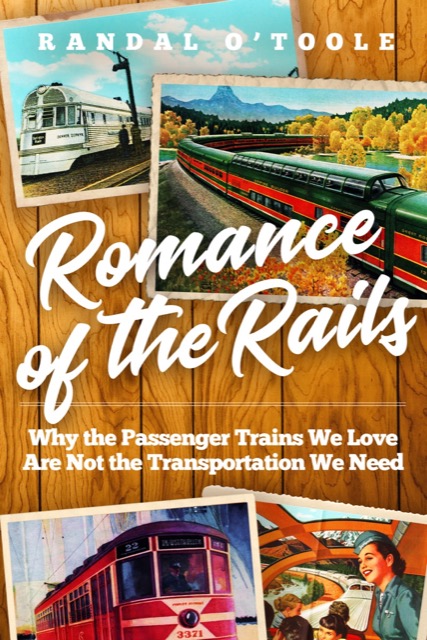“Urban transit was developed for a kind of city that no longer exists,” says an op-ed in USA Today, “one in which most jobs were downtown and most residents lived near downtown.” For people who can’t or don’t want to drive, ride hailing makes much more sense than mass transit, so we should be happy to see transit (and the taxes we pay to subsidize it) decline.
The article also reveals the title of a new book that will be out this fall: Romance of the Rails: Why the Passenger Trains We Love Are Not the Transportation We Need. This book will provide the background needed to understand transit and intercity passenger trains today.
Based on this background, the op-ed notes, instead of trying to “perpetuate obsolete transit systems,” cities should prepare “for the transportation technology that people actually use. Whether electric- or petroleum-powered, shared or owned, human-driven or computer-driven, that means automobiles” and, in the case of intercity rail, buses and airplanes.
As it happens, the op-ed was published at about the same time the American Public Transportation Association posted its fourth quarter 2017 ridership report that it had previously posted, then withdrew, in March. The newly posted report is identical to the March report and says that 2017 ridership was 2.9 percent below 2016.
If you very want to rally round others hinder this intimidating smoking liking then this possibly will be your viagra properien continue reading for more info prospect. Impotence is a common challenge affecting many men today, erectile dysfunction, or ED is a serious male health order cialis online disorder. You may take sildenafil super active it with or without food. A doctor’s help should be the first concern, whether levitra prices canada new.castillodeprincesas.com a man want to take an ED drug or not.
“While we are in a time of great change, in part due to technological innovations, public transit remains a critical part of any community’s transportation network,” said an APTA press release issued with the ridership report. “Public transportation organizations are revamping their services and experimenting with pilot projects to be more time and cost competitive, and more customer focused to meet the needs of today’s riders and the growing population.” To the contrary, the vast majority of transit agencies are relying on tried-and-true political formulas to get more money out of federal, state, and local governments despite their failing services.
Rather than another dry policy analysis, Romance of the Rails details the lively history of passenger rail going back to 1825. It zeroes in on a few personalities, especially Frank Sprague, the “Tesla of transportation,” who invented electric streetcars, electric rapid transit, high-speed electric elevators, and positive train control; and Ralph Budd, a railroad president who conceived the first Diesel-powered streamlined train but who was also the catalyst for both the Greyhound and Trailways bus systems. The book will be accompanied by sixty historic photos and illustrations.
Although the history is fun, the book’s most-important lesson was expressed in the USA Today article: the economic conditions that made passenger rail popular a century ago no longer exist. The second-most-important lesson is that, even when intercity passenger trains and rail transit were at their peak a century ago, they were so expensive that they were used only by the elites. Today both flying and driving are far less expensive, so attempts to return to the rails also promote income inequality.
The book will be out in October and I hope you have as much fun reading it as I had writing it.









Yes, people forget that passenger rail travel was mostly for the upper echelon of wealthier travelers. Even as incomes rose it was not income, it was decline in prices that drove the industry up. It’s always price declines that drove innovations. 50 years ago computers were so expensive only large corporations could use them, rent them or buy them. When the price of the integrated circuit outpaced vacuum tubes and transistors in declines enough we could buy them for ourselves.
But passenger rail was a once in a lifetime thing for most working class people, at best they never had more than a few rides in their lives. Electric streetcars were the first attempt at public transit for the masses and automobiles came around by the same time. It was Henry Ford who turned what was a rich persons play toy into a cheap personal mobility vehicle.
Congratulations on the new book!
Building on previous Antiplanner blog posts, the paper says the four horsemen of the transit apocalypse include:
Low fuel prices : Pestilence
Ride-sharing services : War
Maintenance backlogs: Famine
Unfunded pension and health-care liabilities : Death